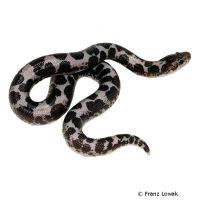Sand Boa (Eryx colubrinus)
| Sand Boa Eryx colubrinus | |
|---|---|
| Name | Sand Boa |
| Name Lat. | Eryx colubrinus |
| Synonym | Gongylophis colubrinus |
| Family | Boas |
| Family lat. | Boidae |
| Order | Scaled Reptiles |
| Order lat. | Squamata |
| Origin | Africa |
| Habitat | Semi-deserts, steppes |
| Diet | Small mammals |
| Humidity | 40-60 % |
| Behavior | Nocturnal, peaceful |
| Keeping | Individual, pair |
| Care Level | Moderate |
| Reproduction | Ovoviviparous |
| Housing | Dry terrarium |
| Life Span | 15-20 years |
| Protection | CITES Appendix II; EU Annex B |
| Metric Units | |
| Size | 70 cm |
| Temperature | 25-30 °C |
| Temperature Local | 35 °C |
| Housing Size | 80 x 50 x 60 cm |
| US Units | |
| Size | 28" |
| Temperature | 77-86 °F |
| Temperature Local | 95 °F |
| Housing Size | 30" x 20" x 25" |
Distribution and habitat
The range of the ground-dwelling, mainly crepuscular and nocturnal East African sand boas extends from Egypt to Tanzania, west to Libya, Chad and Niger. They inhabit sandy semi-deserts, steppes and light scrubland.
Maintenance
Minimum dimensions for the terrarium, according to the size and number of animals
| 1-2 animals | 0,75KL x 0,5KL x 0,5KL (L x W x H) |
Body length (KL) is measured on the largest animal. For each additional animal the floor space should be increased by 20%. A terrarium of e.g. L 80 x W 50 x H 60 cm is recommended, which should be placed in a quiet and vibration-free place.
They need a terrarium structured with low climbing branches and stones (hiding places, visual protection), a 10-20 cm deep diggable sand layer (2-3 mm grain size) interspersed with stone chunks and a shallow stone cave. The water basin should be placed slightly elevated to prevent silting. A small part of the substrate should always be kept moist. Once a day, preferably in the evening, the inside of the terrarium should be finely sprayed with water (humidity), but a rain or mist system is better
| Temp. day: 25-30 °C | Temp. night: 20-22 °C | Temp. local: up to 35 °C | Humidity: 40-60 |
Thermostatically controlled floor heating is recommended. Lighting duration must be 12-14 hrs depending on the season. Daylight fluorescent tubes are ideal.
Diet
They feed on mice, rats and other rodents according to their size. After acclimation, they often succeed in switching to dead food animals (commercial frozen food). Young animals should be offered food every 8-10 days, adults every 14-20 days, with an occasional fasting period (e.g. skip a feeding). Generally, it is better to offer several small feeders, rather than one large one. If she does not eat for an extended period, both the timing and the food should be varied. It is important to enrich the food animals with vitamins and minerals. Since the snake could be injured by live rodents, it should not be left unattended with them.
A varied diet promotes health and prevents deficiency symptoms.
Reproduction and breeding
Probing by the veterinarian is the only reliable method of sex determination
They are viviparous (ovoviviparous). The gestation period is 6-8 months, the fully developed 3-22 young are 12-18 cm long and can be fed young mice
Life expectancy can be 15-20 years.
Species protection
The animal population must be reported in writing to the competent authority immediately after the start of keeping. Subsequently, all arrivals and departures must be reported. Your pet store will be happy to provide you with further information.
Protection of species: WA Appendix II; EU Appendix B. The proof of purchase is the required proof of origin for the animal. Please keep it safe!
Important
Sand boas like to burrow into the top layer of sand. They are bred in different color and pattern variations
For the resting phase, the lighting duration is reduced by 2-4 hours for 1-3 months and the temperature is lowered by 3-4 °C, depending on the origin
When handling always have ready snake hooks, protective gloves and cold water.
The terrarium must have good ventilation without drafts and meet the species specific needs. Measuring devices such as thermometers, hygrometers, etc. are necessary. The lighting has to correspond to the species-specific day-night rhythm and has to be placed in such a way that the animals cannot injure themselves. The terrarium should be locked in such a way that neither unauthorized persons can open it nor the animals can escape. Contamination must be removed regularly
Further literature can be found in your pet store.
References
Text: Clemens Kapsreiter; Image: Franz Lowak
Source: BMELV (1997): Tierschutzgutachten - Mindestanforderungen an die Haltung von Reptilien; ENGELMANN (2006): Zootierhaltung - Tiere in menschlicher Obhut: Reptilien und Amphibien, Harri Deutsch Verlag
- Gemäß § 21 Abs. 5 Tierschutzgesetz idgF
